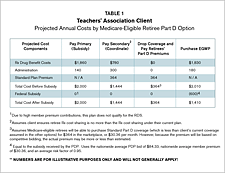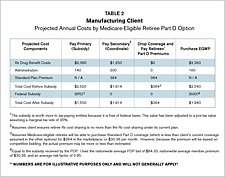Milliman was engaged by two plan sponsors to evaluate their options and help them decide on optimal strategies for providing retiree prescription drug coverage in conjunction with Medicare. An analysis of all possibilities led to a different choice for each plan sponsor.
Medicare's prescription drug options
The plan sponsor retiree drug subsidy (RDS) was created by the Medicare Modernization Act of 2003, to encourage plan sponsors to continue offering retiree prescription drug coverage. This approach was deemed the path of least resistance by the Centers for Medicare and Medicaid Services (CMS) and has been the most popular to date. However, several other options exist for retiree plan sponsors under Medicare Part D that can prove more cost effective. The optimal choice depends on many factors, such as a plan's size, tax status, collective bargaining agreements, and premium contribution. These options include:
- wrapping coverage around an individual Part D plan;
- purchasing group coverage directly through a Medicare Advantage (MA-PD) or prescription drug plan (PDP) under an employer group waiver plan (EGWP); or,
- dropping prescription drug coverage for Medicare-eligible retirees and possibly paying some or all of the retiree's individual coverage premium.
Exploring alternatives to RDS
One client, a large East Coast teachers' association with roughly 10,000 Medicare-eligible enrollees, was faced with lower state reimbursement for healthcare because of state budget cuts and was looking for ways to reduce its healthcare costs. Working collaboratively with the client, Milliman reviewed its current choice, the RDS, as well as all other available options, weighing both financial and administrative concerns with consideration of the organization's present and future plan goals.

For this teachers' association, moving to an EGWP made the most sense (see Table 1) because they did not want to drop coverage altogether.
One important reason: Our analysis revealed that the plan sponsor was increasing member premium contributions and copays to the extent that it would no longer be eligible for the RDS. To qualify for the RDS, a plan's benefit design must be at least as good as the standard Medicare Part D plan design and must be sufficiently funded by the plan sponsor relative to Medicare. This client was going to fail this two-pronged test.
As a result, the EGWP was a strong choice because plan sponsors can still receive subsidies to offset plan sponsor or beneficiary costs, even if they require plan participants to pay as much as 100% of their premium costs. The sponsor had the reassurance of knowing future premium contribution increases would not endanger the subsidy.
Choosing an EGWP was also a better option for the plan sponsor in regard to reporting requirements. The emerging GASB 45 regulations only allow plans to report their RDS reimbursement in the current year, requiring that future years be projected at the full cost without the RDS. However, because an EGWP provides a subsidy that directly reduces a plan sponsor's premium and doesn't require an annual attestation as the RDS option does, the EGWP subsidy is included for all future year projections. By switching from the RDS to an EGWP, the sponsor was able to benefit from this reporting advantage.
The plan sponsor was also eager to lessen its administrative burdens, which were fairly significant when applying for the RDS. The EGWP option allowed the plan sponsor to transfer most of its administrative duties to the EGWP administrator. In addition, federal reinsurance available under an EGWP helped reduce benefit costs.
This plan sponsor was thrilled to learn it could continue to receive some government subsidies, despite increasing its member premium contributions and cost sharing to a level that disqualified it for the RDS. The plan then issued a request for proposals and was able to solicit several competitive EGWP quotes.
Milliman assisted the association in evaluating the EGWP quotes and provided guidance on its communications strategy after it selected a provider. The client was able to smoothly transition to an EGWP and received no negative feedback from participants, even though the plan sponsor required higher out-of-pocket premiums and cost sharing when it made the change to the EGWP.
Staying the course—RDS as the best option

One large manufacturer in the Great Plains states was using the RDS for its retiree prescription drug plan with about 13,000 Medicare-eligible enrollees. The company was contemplating continuing this policy, but wanted to make sure it was being fiscally responsible in evaluating all possible alternatives. Milliman provided a complete analysis of all available options (Table 2).
The RDS was the optimal choice for several reasons. The paternalistic nature of the plan sponsor meant that plan managers did not want to drop coverage and leave its retirees to find individual coverage on their own, feeling it might lead to bad publicity and negative views of the company by current employees and the larger community. Continuing with the RDS allowed the plan benefits to remain unchanged—unlike the other options—thereby minimizing disruption to its retiree population.
Another key factor in remaining with the RDS was its status as a tax-free subsidy. This factor made it valuable to the taxable plan sponsor.
This plan sponsor was satisfied that it had considered its retiree prescription drug options and made an educated decision on the optimal approach based on its own circumstances and priorities. It was important for this client to perform this quantitative analysis, weigh the potential savings for each option, and overlay the comparison with the qualitative factors before making a decision to continue with the RDS option.